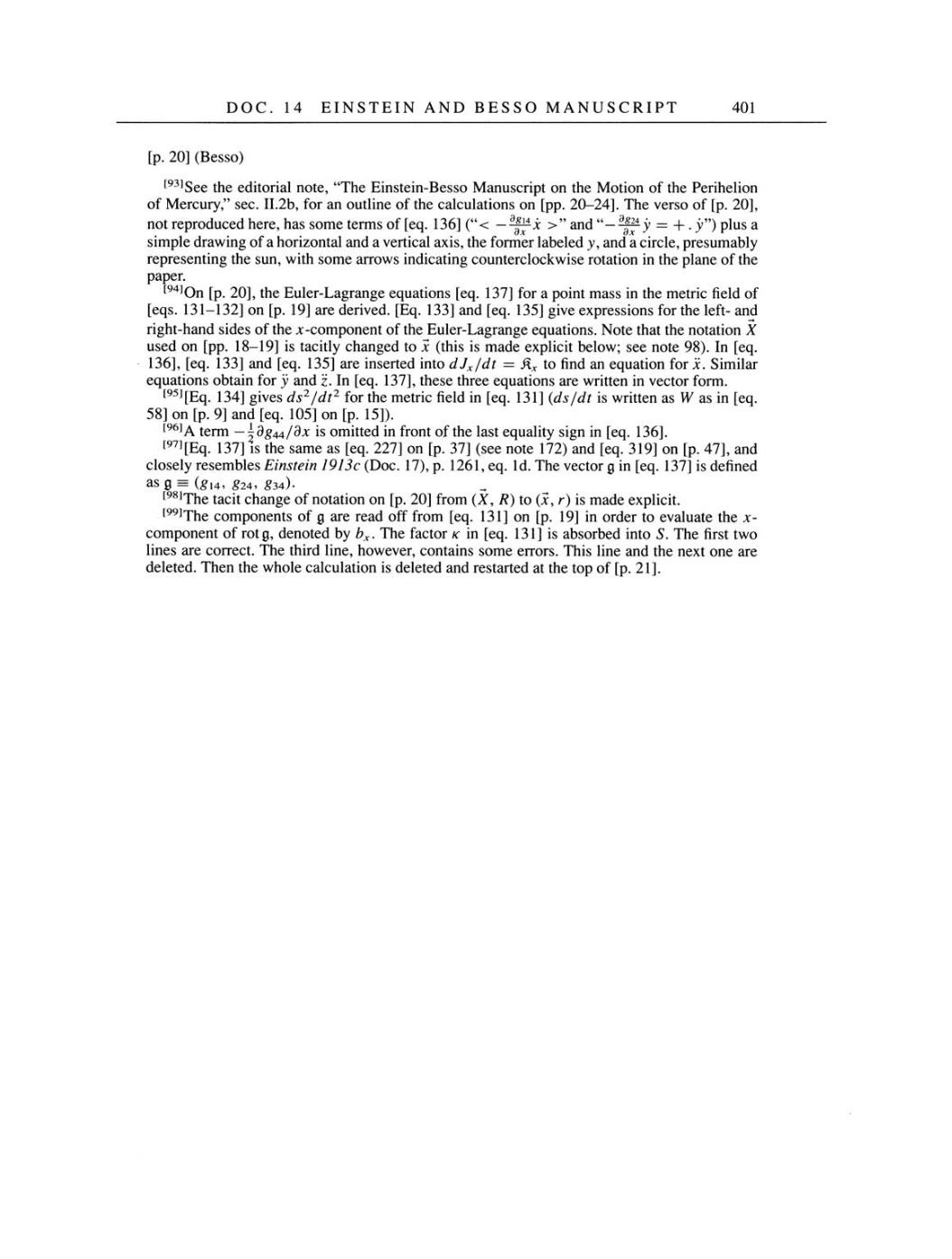DOC. 14
EINSTEIN
AND
BESSO MANUSCRIPT
401
[p.
20]
(Besso)
[93]See
the editorial
note,
"The Einstein-Besso
Manuscript
on
the Motion of the Perihelion
of
Mercury,"
sec.
II.2b,
for
an
outline
of the
calculations
on
[pp.
20-24].
The
verso
of
[p. 20],
not reproduced
here,
has
some
terms
of
[eq.
136]
("
-dg14/dx
"
and
"-dg24/dxy+
= .
y") plus
a
simple
drawing
of
a
horizontal and
a
vertical
axis,
the former labeled
y,
and
a
circle,
presumably
representing
the
sun,
with
some arrows indicating
counterclockwise rotation
in
the
plane
of
the
paper.
[94]On
[p. 20],
the
Euler-Lagrange equations
[eq.
137]
for
a
point
mass
in
the metric
field
of
[eqs.
131-132]
on [p.
19]
are
derived.
[Eq. 133]
and
[eq. 135] give expressions
for the left-
and
right-hand
sides of
the
x-component
of
the
Euler-Lagrange equations.
Note that the notation
X
used
on [pp.
18-19] is
tacitly changed
to
x
(this is
made
explicit below;
see
note 98).
In
[eq.
136],
[eq.
133]
and
[eq.
135] are
inserted
into
dJx/dt
=
sx
to find
an
equation
for
x.
Similar
equations
obtain
for
y
and
z.
In
[eq.
137],
these three
equations
are
written
in
vector
form.
[95][Eq. 134] gives
ds2/dt2 for the metric
field in
[eq.
131]
(ds/dt
is
written
as
W
as
in
[eq.
58] on [p. 9]
and
[eq.
105]
on [p.
15]).
[96]A
term
-
1/2dg44/dx
is
omitted in front of
the
last
equality
sign
in
[eq.
136].
[97][Eq. 137] is
the
same
as
[eq. 227]
on
[p. 37]
(see note
172)
and
[eq.
319]
on [p.
47],
and
closely
resembles Einstein
1913c
(Doc. 17),
p.
1261, eq. 1d.
The
vector
g
in
[eq.
137]
is
defined
as
g
= (g14, g24, g34).
[98]The
tacit
change
of notation
on
[p.
20]
from
(X,
R)
to (x,
r)
is
made
explicit.
[99]The
components
of
g
are
read off from
[eq.
131] on
[p. 19]
in
order
to
evaluate the
x–
component
of
rot
g,
denoted
by bx.
The factor
k
in
[eq.
131]
is
absorbed
into S.
The
first two
lines
are
correct.
The third
line,
however,
contains
some
errors.
This line and the
next
one are
deleted. Then the whole calculation
is
deleted
and restarted
at
the
top
of
[p.
21].
